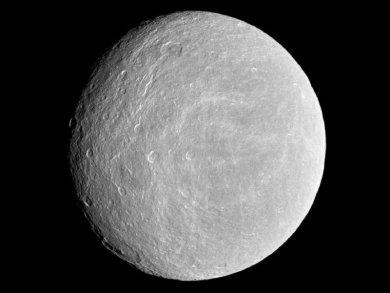Results from the Cassini-Huygens mission reveal oxygen and carbon dioxide in the atmosphere of Rhea, Saturn’s second largest moon. The O2/CO2 atmosphere is thought to be sustained by high energy particles from Saturn’s magnetic field bombarding Rhea’s surface of ice and ejecting atoms, molecules and ions into the atmosphere.
The two gases were detected by Cassini’s ion and neutral mass spectrometer when Cassini swept within 100 km of the moon’s surface in March 2010. Peak densities of oxygen of around 50 billion molecules per cubic meter were detected with peak densities of carbon dioxide around 20 billion molecules per cubic meter.
This is the first time a spacecraft has captured direct evidence of an oxygen atmosphere at a world other than Earth and the discovery provides key information on how radiation can drive chemistry on icy surfaces throughout the universe.
Image: (c) NASA/JPL/Space Science Institute
- Cassini Finds an Oxygen–Carbon Dioxide Atmosphere at Saturn’s Icy Moon Rhea
B. D. Teolis, G. H. Jones, P. F. Miles, R. L. Tokar, B. A. Magee et al.,
Science 2010.
DOI: 10.1126/science.1198366 - Cassini-Huygens Mission




